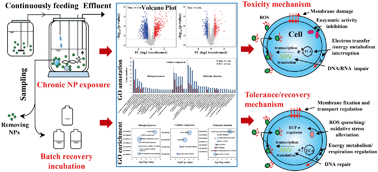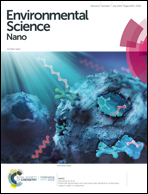Mechanistic insights into stress response and metabolic activity resilience of Nitrosomonas europaea cultures to long-term CeO2 nanoparticle exposure†
Abstract
Although the negative effects of CeO2 nanoparticles (nano-CeO2) on wastewater biological nitrogen removal (BNR) systems have been documented, the potential and mechanisms of the stress tolerance and resilience of nitrifiers to nano-CeO2 exposure remain unclear. Herein, we explored the long-term impacts of nano-CeO2 on a continuously cultured model ammonia oxidizer, Nitrosomonas europaea, and assessed the recovery capacities of nano-CeO2 stressed cells at the physiological and transcriptional levels. Nano-CeO2 at 50 mg L−1 remarkably inhibited the bacterial growth, the membrane integrity, the ammonium removal performance and the specific ammonia monooxygenase activity. Meanwhile, N. europaea exhibited a tolerance capacity to the nano-CeO2 stress and their metabolic activities were maintained even after 40 d nano-CeO2 exposure. The batch recovery incubation study revealed the inhibition level-dependent recovery potential of nano-CeO2 impaired N. europaea cultures. Transcriptomics-based investigation indicated that nano-CeO2 induced the disruptions of the membrane structure and the associated transport systems. Nevertheless, the peptidoglycan biosynthesis and ATP-binding cassette transport relevant metabolism regulation probably played a pivotal role in cellular stress tolerance/recovery. In particular, the transcriptional regulation of energy metabolism pathways, such as CO2 fixation, respiratory chain and ATP production, might favor the bacterial protection/recovery from the nano-CeO2 stress. Moreover, diverse metabolic regulation at the transcriptional levels, including DNA repair, oxidative stress quenching, and signal transduction would be actively involved in cellular protection against nano-CeO2 and impaired cells' metabolic activity recovery. These findings improved our understanding of stress responses and resilience of nitrifiers to NPs and provided novel insights into adjustment strategy determination for the potential NP impacts on BNR systems.

- This article is part of the themed collection: Nanomaterials in air


 Please wait while we load your content...
Please wait while we load your content...